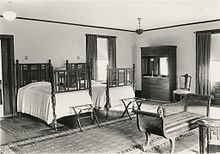User:Mchang47/sandbox
Mary Elizabeth Garrett (5 March 1854 - 3 April 1915) was an American suffragist and philanthropist.
Biography[edit]
Mary Garrett was the daughter of John W. Garrett, a philanthropist and president of the Baltimore and Ohio Railroad (B&O). She became the wealthiest "spinster woman" in the country with the demise of her father.
Garrett was a part of a group of intellectual women known as "Friday Evening" whose fathers were all on the board at the Johns Hopkins School of Medicine or Johns Hopkins Hospital, who were instrumental in advocating for autonomy and equal privileges for women, especially intellectually.[1]
At her death, she gave $15,000,000 to M. Carey Thomas, the president of Bryn Mawr College, with whom she was romantically involved and had lived with at Bryn Mawr in the Deanery.[2]
She is buried in Green Mount Cemetery, Baltimore, MD.[3]
Work[edit]
Prior to inheriting a fortune of about $2 million following her father's death[4], Mary worked as a personal secretary for her father, John W. Garrett. This experience exposed Mary to professional finance and endowed her with the skills to be an effective negotiator and businesswoman.[3]
Using her inherited wealth, Garrett helped found the Bryn Mawr School for Women, so named to reference the already-popular Bryn Mawr College of Pennsylvania, which focused on scholastic achievement in traditionally male-dominated disciplines, such as mathematics and science. Although she was greatly hailed for her work, her donations were also controversial at the time and sometimes criticized for breaking social norms. For instance, "The Kitchen Magazine asked, 'Why does not Miss Garrett or some other philanthropist invest a quarter of a million dollars in a model school of domestic economy, in which we prepare girls for housekeeping and homemaking,' adding that 'without thoroughly trained, competent housekeepers it is a folly to hope for well-trained, pleasant homes.'"[3]
She also enriched Bryn Mawr College, donating $10,000 per year to help the college. She also endowed the Johns Hopkins School of Medicine and secured the rights of women to attend thus making it the first co-educational, graduate-level medical school in the United States.[5]

Garrett was also heavily involved in the Women's Suffrage Movement, organizing the National American Woman Suffrage Association's national convention in 1906. She continued to donate heavily to the movement until her death.
 | This is a user sandbox of Mchang47. You can use it for testing or practicing edits. This is not the sandbox where you should draft your assigned article for a dashboard.wikiedu.org course. To find the right sandbox for your assignment, visit your Dashboard course page and follow the Sandbox Draft link for your assigned article in the My Articles section. |
- ^ "A Biographical Sketch of Mary Elizabeth Garrett..." The Johns Hopkins University School of Medicine. Johns Hopkins University. Retrieved 31 December 2014.
- ^ Lillian Faderman, Odd Girls and Twilight Lovers: A History of Lesbian Life in Twentieth-Century America, Penguin Books Ltd, 1991, page 30. ISBN 0-231-07488-3
- ^ a b c Sander, Kathleen Waters (2008). Mary Elizabeth Garrett : society and philanthropy in the Gilded Age. Baltimore, Md.: Johns Hopkins University Press. ISBN 9780801888700.
- ^ Mukau, Leslie (2012). "Johns Hopkins and the Feminist Legacy: How a Group of Baltimore Women Shaped American Graduate Medical Education" (PDF). American Journal of Clinical Medicine. 9: 118–127 – via American Association of Physician Specialists.
- ^ The Philanthropy Hall of Fame, Mary Garrett
